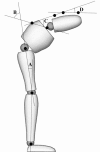Changes in the flexion-relaxation response induced by hip extensor and erector spinae muscle fatigue
- PMID: 20525336
- PMCID: PMC2896348
- DOI: 10.1186/1471-2474-11-112
Changes in the flexion-relaxation response induced by hip extensor and erector spinae muscle fatigue
Abstract
Background: The flexion-relaxation phenomenon (FRP) is defined by reduced lumbar erector spinae (ES) muscle myoelectric activity during full trunk flexion. The objectives of this study were to quantify the effect of hip and back extensor muscle fatigue on FRP parameters and lumbopelvic kinematics.
Methods: Twenty-seven healthy adults performed flexion-extension tasks under 4 different experimental conditions: no fatigue/no load, no fatigue/load, fatigue/no load, and fatigue/load. Total flexion angle corresponding to the onset and cessation of myoelectric silence, hip flexion angle, lumbar flexion angle and maximal trunk flexion angle were compared across different experimental conditions by 2 x 2 (Load x Fatigue) repeated-measures ANOVA.
Results: The angle corresponding to the ES onset of myoelectric silence was reduced after the fatigue task, and loading the spine decreased the lumbar contribution to motion compared to the hip during both flexion and extension. A relative increment of lumbar spine motion compared to pelvic motion was also observed in fatigue conditions.
Conclusions: Previous results suggested that ES muscles, in a state of fatigue, are unable to provide sufficient segmental stabilization. The present findings indicate that, changes in lumbar-stabilizing mechanisms in the presence of muscle fatigue seem to be caused by modulation of lumbopelvic kinematics.
Figures




Similar articles
-
Changes in the flexion relaxation response induced by lumbar muscle fatigue.BMC Musculoskelet Disord. 2008 Jan 24;9:10. doi: 10.1186/1471-2474-9-10. BMC Musculoskelet Disord. 2008. PMID: 18218087 Free PMC article.
-
The relationship between flexibility and EMG activity pattern of the erector spinae muscles during trunk flexion-extension.J Electromyogr Kinesiol. 2009 Oct;19(5):746-53. doi: 10.1016/j.jelekin.2008.02.004. Epub 2008 Apr 8. J Electromyogr Kinesiol. 2009. PMID: 18400517
-
Repeated spinal flexion modulates the flexion-relaxation phenomenon.Clin Biomech (Bristol). 2003 Nov;18(9):783-9. doi: 10.1016/s0268-0033(03)00166-9. Clin Biomech (Bristol). 2003. PMID: 14527804 Clinical Trial.
-
Response of the flexion-relaxation phenomenon relative to the lumbar motion to load and speed.Spine (Phila Pa 1976). 2001 Sep 15;26(18):E421-6. doi: 10.1097/00007632-200109150-00019. Spine (Phila Pa 1976). 2001. PMID: 11547213
-
The biomechanical and clinical significance of the lumbar erector spinae flexion-relaxation phenomenon: a review of literature.J Manipulative Physiol Ther. 2005 Oct;28(8):623-31. doi: 10.1016/j.jmpt.2005.08.005. J Manipulative Physiol Ther. 2005. PMID: 16226632 Review.
Cited by
-
Age and gender related neuromuscular changes in trunk flexion-extension.J Neuroeng Rehabil. 2015 Jan 7;12(1):3. doi: 10.1186/1743-0003-12-3. J Neuroeng Rehabil. 2015. PMID: 25566847 Free PMC article.
-
Short term modulation of trunk neuromuscular responses following spinal manipulation: a control group study.BMC Musculoskelet Disord. 2013 Mar 13;14:92. doi: 10.1186/1471-2474-14-92. BMC Musculoskelet Disord. 2013. PMID: 23496876 Free PMC article. Clinical Trial.
-
The association of reactive balance control and spinal curvature under lumbar muscle fatigue.PeerJ. 2021 Aug 10;9:e11969. doi: 10.7717/peerj.11969. eCollection 2021. PeerJ. 2021. PMID: 34434668 Free PMC article.
-
Changes in pregnancy-related hormones, neuromechanical adaptations and clinical pain status throughout pregnancy: A prospective cohort study.PLoS One. 2025 Feb 21;20(2):e0314158. doi: 10.1371/journal.pone.0314158. eCollection 2025. PLoS One. 2025. PMID: 39982927 Free PMC article.
-
Differential Back Muscle Flexion-Relaxation Phenomenon in Constrained versus Unconstrained Leg Postures.Bioengineering (Basel). 2024 Jul 20;11(7):736. doi: 10.3390/bioengineering11070736. Bioengineering (Basel). 2024. PMID: 39061818 Free PMC article.
References
Publication types
MeSH terms
LinkOut - more resources
Full Text Sources
Miscellaneous

